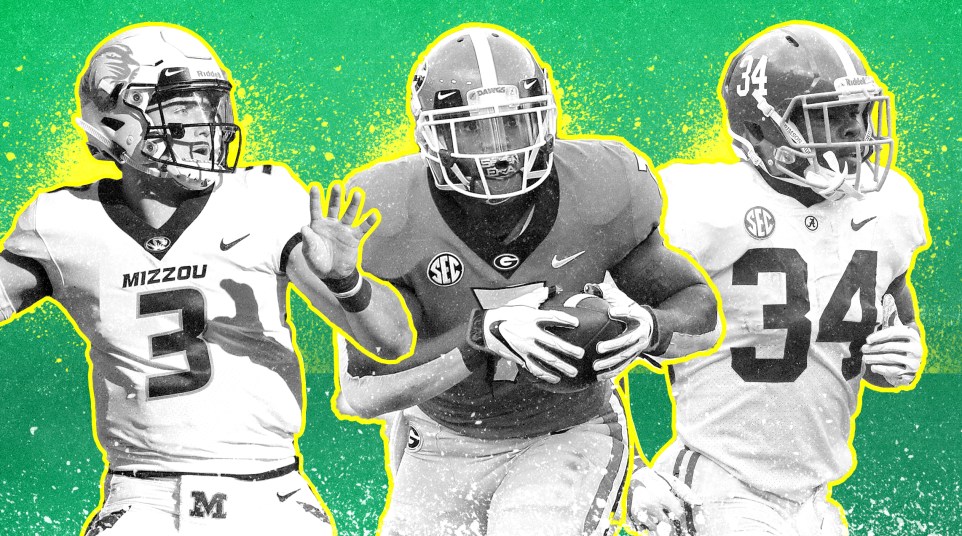
Monday Down South: Is this the best Alabama team Nick Saban has had? It's beginning to look and feel that way
November is less than a week old, and there’s still too much football left to be played to anoint the 2018 Crimson Tide as Nick Saban’s best. We should know better by now: In Saban’s tenure Alabama has held the No. 1 spot in the AP poll at this point on the calendar on five other occasions (as it does now, unanimously), boasting an undefeated record each time (as it does now), and all five of those teams lost at least one game in the final weeks of the regular season or in the postseason. Most were considered more or less unbeatable at the time, as the Tide look to be right now.
Still, this edition certainly remains on schedule to challenge for that title, and if it proved anything new in Saturday night’s 29-0 pasting of LSU — an annual rite of passage that unfolded according to essentially the same script as all of Alabama’s other pastings of LSU — it’s that, of all the Saban-era juggernauts, the 2018 Tide is continuing to shape up as the most well-rounded. There’s nothing unique about a Bama team that cruises through the first three-fourths of the regular season while hardly a breaking a sweat. But there hasn’t been another one that can break opponents down in as many different ways.
That begins, of course, with the transformative presence of Tua Tagovailoa behind center. By his standards, though, Tua had a very mortal night in Baton Rouge, throwing his first interception of the season and coming in well below his usual off-the-charts efficiency on a sore right knee. (Tagovailoa actually ceded the national lead in pass efficiency for the first time this year, falling slightly behind Oklahoma’s Kyler Murray.)
Theoretically, that sounds like the best possible scenario for LSU’s defense. In reality, it made no difference whatsoever: With the passing game set to “medium,” Bama got back to basics between the tackles, grinding out its best rushing effort of the year in terms of both yards (281) and yards per carry (7.6), and ultimately exceeding its season average for total offense — all at the expense of ostensibly the best defense it will face until well into the postseason, one that’s just a few weeks removed from stuffing Georgia’s run-first offense into a burlap sack. The Tigers held up about as well as they could have hoped against the best quarterback in college football, and instead got force-fed their worst performance against the run since 2015.
Even if the Tide aren’t strictly unbeatable, there’s no obvious formula for beating them. On paper, the ground game has occasionally lagged (most notably against Texas A&M) and lacks the kind of every-down workhorse that has headlined some of Saban’s best teams; in a pinch, it’s still a deep, ludicrously talented unit that’s more than capable of picking up the slack when Tagovailoa’s output is merely above-average.
Statistically, the defense remains a whisker off the pace of the impenetrable units that anchored all of the recent championship runs; it’s still a top-10 unit that matches up athletically with any offense it could conceivably face and just proved itself capable of administering a standard-issue Bama beatdown to a quality opponent. The kicking game is on shakier ground; good luck finding yourself in a position where a miss might actually matter.
It must also be said that even the banged-up, flesh-and-blood version of Tagovailoa is one the vast majority of teams would trade for in a heartbeat. His first “down” night of the season (relatively speaking) still yielded 295 yards and 2 touchdowns on a career-high 42 attempts, plus a long rushing TD on the gimpy knee. And as I’ve pointed out before, the transcendent talent at quarterback is matched by the most explosive set of receivers that Alabama has had, or that any team has right now in the college game.
Although he didn’t connect on one of his trademark bombs against LSU’s NFL-ready secondary, Tua still benefited Saturday from jaw-dropping plays by almost all of his primary targets, from a one-handed gem by Henry Ruggs …
OH MY.
Henry Ruggs only needs one hand. pic.twitter.com/BxGBaUM6Pr— CBS Sports (@CBSSports) November 4, 2018
… to a balletic sideline catch by Jaylen Waddle…
HOW did he keep his feet in?? pic.twitter.com/k2M0liUCkY
— CBS Sports (@CBSSports) November 4, 2018
… to Jerry Jeudy straight-up clowning would-be tacklers in the open field:
Jerry Jeudy has moves. pic.twitter.com/n3FSs7xXUu
— CBS Sports (@CBSSports) November 4, 2018
Again, those are highlights from just one half of the least productive game this group has played this season. Until further notice, that is the best opposing defenses can realistically hope for. And if not LSU’s defense, who else in college football this season is capable of delivering that notice?
Notebook
Around the conference.
— Timothy Burke (@bubbaprog) November 4, 2018
Alabama 29, LSU 0
The further we get from the height of Burrow Mania, the harder it’s going to be to believe that anyone ever really considered Joe Burrow to be a more plausible threat against Alabama than his underwhelming predecessors. (Much less this version of Alabama, which clearly posed a greater challenge than the more conservative Bama outfits that have been content to slug it out with the Tigers in the past.) Almost everything Burrow did over the course of a 7-1 start was interpreted in light of how it would play on this stage, in the defining game of every LSU season, and the answer was just about exactly the same as always:
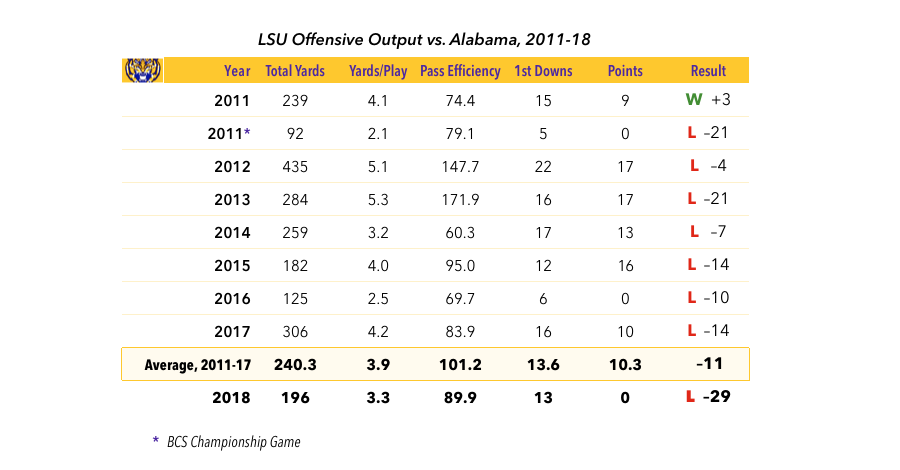
In fairness, that bottom line probably says a lot less about Burrow — or his underwhelming predecessors — than it does about the breakdown of his protection in the face of Alabama’s relentless front seven. LSU’s top running backs, Nick Brossette and Clyde Edwards-Helaire, were nonentities Saturday night, combining for 19 yards on 13 carries; with no ground game to speak of, Burrow was often a sitting duck in the pocket, enduring 5 sacks and countless hits on more than 40 dropbacks.
That’s an untenable number for LSU’s style of play against any defense. By the end of the first half, the ground game commanded such little respect that Bama’s pass rushers felt free to ignore play-action altogether, putting LSU’s already overmatched o-line in a no-win situation and Burrow in the crosshairs.
LOOK OUT, JOE! pic.twitter.com/2w7ml1vvhf
— CBS Sports (@CBSSports) November 4, 2018
That was par for the course, too: Bama sacked Danny Etling 6 times last year and 5 times in 2016.
To his credit, Burrow avoided the killer mistake in the face of that pressure (his only turnover came in garbage time, on LSU’s last possession of the night), and his coaches literally punted on the Tigers’ only remotely plausible scoring chances, opting to boot the ball back to the nation’s No. 1 offense rather than go for it on fourth down on all three trips into Alabama territory prior to the fourth quarter.
But those decisions felt like footnotes, because the opportunities felt strictly hypothetical in the first place. LSU’s offense hasn’t mounted a sustained scoring drive against Alabama’s defense in three years and counting. No matter how hard Ed Orgeron hits the recruiting trail, until he and his staff figure out a way to break out of their one-dimensional shell against Bama the talent gap on the field is not the one that matters the most.
D'Andre Swift, making everyone miss. pic.twitter.com/xYr2dQus3J
— CBS Sports (@CBSSports) November 3, 2018
Georgia 34, Kentucky 17
Georgia fans spent the first half of the season waiting in vain for the running game to revert to its imposing 2017 form, and just when they were beginning to get used to the idea of a riding a more balanced attack into the postseason the backfield exploded for its best performance of the season, by far, against arguably the best defense they’ve faced. (As difficult as it is to reconcile the concepts of “Kentucky football” and “elite defense,” remember the Wildcats came into the game ranked No. 1 nationally in scoring defense after throttling the first two-thirds of their schedule.)
Elijah Holyfield and D’Andre Swift looked like worthy heirs apparent to the thunder-and-lightning motif established last year by Nick Chubb and Sony Michel, and like fully healthy ones, too; Holyfield and Swift both finished with career highs on the ground, racking up 271 yards and 3 touchdowns between them on just shy of 8 yards per carry. Jake Fromm, having re-entrenched himself as the starter against Florida, was back to taking it relatively easy. It’s as close as the Bulldogs have come this year to the ideal template, and it came at the most opportune moment.
As always, that story begins up front, where the UGA offensive line finally played up to its massive size on the heels of lackluster outings against LSU and Florida. After a slow start, the combination of Andrew Thomas, Solomon Kindley, Trey Hill, Cade Mays, and Isaiah Wilson proceeded to grind Kentucky’s overachieving front to dust over the final three quarters, reasserting themselves in the process as the alpha o-line in the conference.
Case in point: D’Andre Swift’s back-breaking, 83-yard touchdown run in the third quarter, a picture-perfect example of team blocking that hinged on the Kindley-Thomas tandem on the left side. At the snap, Kindley and Thomas were tasked with eliminating DT T.J. Carter (No. 90 below) …
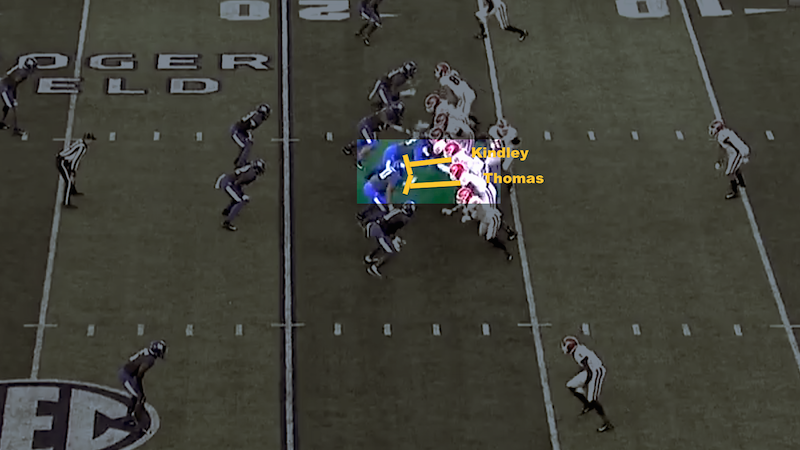
… and subsequently accounting for the play-side linebacker, Chris Oates (No. 22), whose outside pursuit as the play unfolded allowed Thomas to pick him up off the double team while Kindley finished off the block on Carter by himself. Meanwhile, Hill (a true freshman who filled in at center for the injured Lamont Gaillard) neutralized the backside DT on his own, freeing up the left guard, Mays, to advance to the backside linebacker on the second level:
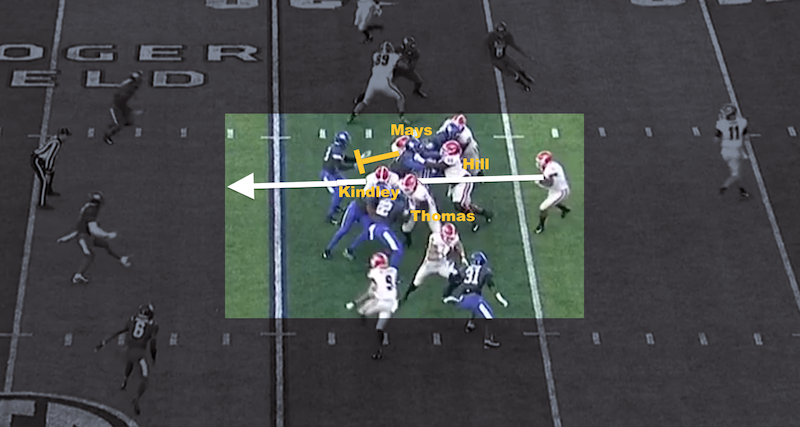
Had CBS bothered with an end-zone camera angle on the replay (cough), what you would see here is a gaping running lane between Hill and Kindley, right down the heart of the defense, with no one left at home between Swift and paydirt. As it is, the sight of him popping out the other side of the line without a glove laid on him pretty well summed it up.
*looks up the definition of swift* pic.twitter.com/HfiP5INqvK
— CBS Sports (@CBSSports) November 3, 2018
There’s some concern going forward about Gaillard, who left the game early with a knee injury, and Mays, who left late with a shoulder injury he had dealt with before; he was replaced by Kendall Baker, a full-time starter during last year’s championship run who had been relegated to a reserve role. The status of another former starter, Ben Cleveland, is also touch-and-go as he recovers from a leg fracture. But after Saturday the combination of blue-chip youth and veteran depth looks is beginning to look like a strength again at exactly the point on the calendar when it stands to make the difference between a championship and a missed opportunity.
Auburn 28, Texas A&M 24; Missouri 38, Florida 17
A&M and Florida have a lot in common — first-year head coaches, sophomore quarterbacks on the upswing, identical trajectories in the polls — so maybe it’s fitting that they find themselves sharing the same seat as a once-promising season enters the stretch run: On a 2-game losing streak, with visions of a New Year’s 6 bowl giving way to the same old malaise that got the last coach fired. This was the weekend that drove home just how just how far both programs still have to go.
For the Aggies, especially, the loss was sobering on multiple levels, beginning with the fact that they led Auburn by 10 points midway through the fourth quarter, 24-14, and seemed to be in firm control before collapsing in a heap over the final few minutes. That’s bad enough in a vacuum; combined with last week’s loss at Mississippi State, it felt like a bad case of deja vu. One of the most obvious reasons Kevin Sumlin was shown the door last winter despite a winning record overall in College Station was his teams’ consistent failure to capitalize on its early-season success, to the extent that A&M’s annual November nosedive became arguably the defining trope of his tenure.
Over his last five seasons Sumlin’s teams went a combined 4-11 in November SEC games, managing to blow a top-10 ranking every year from 2013-16. Now Jimbo Fisher’s first team, which appeared to be ahead of schedule over the course of a 5-2 start — headlined by an encouraging, down-to-the-wire slugfest against Clemson — has suddenly lapsed into the same deflating pattern. A&M is unranked in the new AP poll just two weeks after climbing to no. 16 and likely bound for the TaxSlayer Bowl, at best.
Face-of-the-program QB Kellen Mond looks like he’s regressing. In Gainesville, Feleipe Franks’ status is up in the air after he was benched in the wipeout loss to Mizzou. (I’ll be going into more depth on both Monds and Franks in this week’s edition of QB Curve.) In both cases, the product on the field is largely indistinguishable from where it was this time last year.
Of course, it’s much too soon to start making sweeping judgments about the direction of a program in Year 1 under a new coach, which in the case of both Fisher and Dan Mullen might be more accurately described as “Year Zero.”
Neither roster is fully theirs yet, and both have a chance to reverse the narrative down the stretch, especially in their respective regular-season finales against LSU and Florida State. Neither Aggies nor Gators fans are in any position to complain about an eight- or nine-win season, which remains well within reach for both sides. But they couldn’t have been blamed if they were starting to think a little bigger, and the notion that either team is on the verge of turning a corner in 2018 has been put to bed.
South Carolina 48, Ole Miss 44
Surprise! An Ole Miss game turned into an offensive bonanza with big plays and big numbers across the board. South Carolina scored more points and averaged more yards per play (7.4) than it had in any SEC game since 2014. Altogether, the Rebels have allowed at least 31 points in all five conference games this season, including their lone SEC win against Arkansas. (That one was a comeback in which Ole Miss overcame a nine-point deficit in the fourth quarter; on Saturday, Ole Miss blew a 10-point lead in the fourth quarter. You win some offensive bonanzas, you lose some.) Predictably, they rank dead last in the league in scoring defense, among other notable categories.
In fact, for some context on where things stand with this defense historically, Ole Miss is on pace right now to allow more points in conference play than any other SEC defense since the turn of the century, outpacing even some of the most rock-bottom teams in that span:
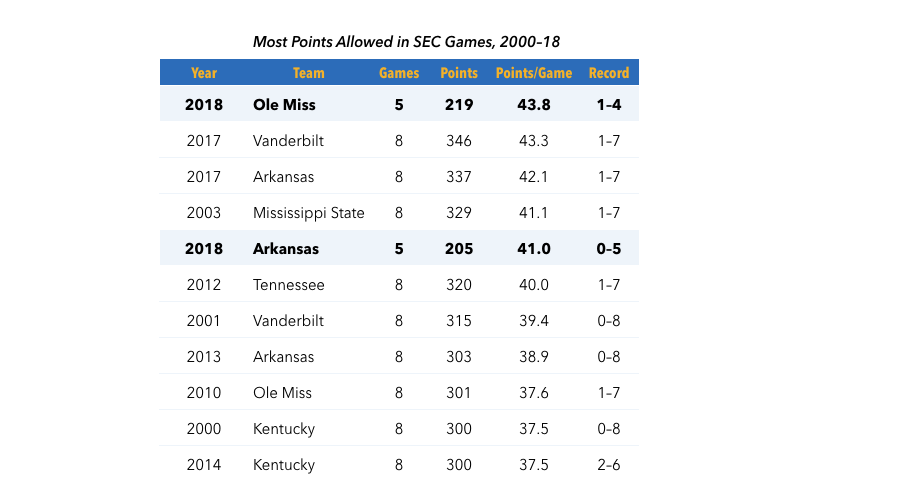
Obviously, that is a looooong way from hey day of the Nkemdiche-led group that led the nation in scoring D back in 2014. Fully half the teams on that list fired their head coach.
Matt Luke is safe for the foreseeable future — i.e., into 2019 — but the same can’t be said for defensive coordinator Wesley McGriff, who’ll likely be the first on the chopping block if Luke opts for (or is left with no choice but to accept) the expected staff overhaul at season’s end. In McGriff’s defense, he’s not working with any Nkemdiches on this depth chart: All but one defensive starter against South Carolina arrived in Oxford as a 3-star recruit, which by SEC standards is like bringing a pistol to a tank fight. (The lone exception: DT Benito Jones, a former 5-star enduring a mediocre campaign in his third year on campus.) There are no seniors in the lineup, either. Whether or not they wind up on top of the Most Generous list, with nothing in particular to play for over the next few weeks it’s a safe bet that it’s going to be up to the offense to keep the Rebels from spiraling out.
Superlatives
The best of Week 10 …
Quinnen Williams was the best player on the field against LSU. Constantly disruptive, showing violent hands, power and ability to finish plays. Easily a Top-5 pick. pic.twitter.com/jXWUyewc8B
— J Reid (@JReidNFL) November 4, 2018
1. Alabama DT Quinnen Williams. Saturday night was the night Williams officially graduated from “emerging star” to “force of nature,” clinching a spot on postseason All-America teams with a team-high 10 tackles from the interior line — 4 of them for loss, 3 of them sacks — in Bama’s most suffocating defensive effort of the year. That was in keeping with his season-long dominance at the nose: Williams started the night as the highest-graded defensive player in the nation, according to Pro Football Focus, and ended it as a potential top-10 draft pick in a loaded class of defensive linemen. If he wasn’t playing on the same team with a generational talent behind center, he’d be in line for some darkhorse Heisman hype in his own right.
2. Auburn DT Derrick Brown. Brown had a generally productive afternoon in the win over Texas A&M, registering 3 tackles for loss and joining Williams on PFF’s National Team of the Week. He was at his best, though, when it mattered most: With Auburn trailing late in the fourth quarter, 24-21, and desperately needing a stop, Brown powered his way into the backfield on consecutive plays for a strip sack (forcing a fumble that was recovered by A&M) and a screen-busting QB hurry, almost singlehandedly forcing the Aggies to go 3-and-out with the game on the line; the subsequent punt set up the Tigers’ go-ahead touchdown with less than 2 minutes to play.
From there, Brown put his stamp on the comeback by swatting a pass on A&M’s last-gasp drive to close the game, followed by a holding penalty that effectively ended it by pushing the Aggies out of range of a Hail Mary. On the two decisive series of the game he was unblockable.
3. Texas A&M RB Trayveon Williams. The Aggies’ late collapse at Auburn shouldn’t take away from Williams’ multi-faceted effort, which yielded 182 yards from scrimmage (107 rushing, 75 receiving) and all 3 A&M touchdowns on 22 touches. That was enough for him to surpass Benny Snell Jr. as the SEC leader in all-purpose yards for the season, and hopefully to put Williams’ name in the All-America mix even as his team fades from the national radar.
Trayveon Williams to the house. #DevyWatch pic.twitter.com/7kGN9MXYn4
— Greg Brandt (@devywarehouse) November 3, 2018
4. Missouri QB Drew Lock. I’ve harped repeatedly this season on Lock’s tendency to rack up huge numbers against the bottom half of the schedule while showing little to no improvement against the top half. So while his 250-yard, 3-touchdown afternoon at Florida was par for the course in terms of his overall production, in terms of the level of competition it stood out as one of the best performances of his career, complete with a new milestone in the SEC record books to commemorate it.
With this TD pass Drew Lock passes Tim Tebow and Chris Leak IN FLORIDA for 3rd all-time in TD passes in SEC history. He is tied with Peyton Manning with 89!!
Also… Mizzou's up 28-10 at the swamp! pic.twitter.com/27emueEgk7
— New Account (@ftbeard_17) November 3, 2018
That was Lock’s second touchdown pass; his third moved him in front of Manning on the career TD list with at least three games (and probably four) left to play. Not a bad place to wind up for a guy whose freshman campaign ended with just 4 TDs to 8 interceptions.
5. South Carolina QB Jake Bentley. Granted, Ole Miss’ defense is terrible. And yes, the Gamecocks’ rally from a 10-point deficit in the fourth quarter was driven almost exclusively by the running game. The win still goes in the books as a banner day for Bentley, who set career highs for both passing yards (363) and yards per attempt (11.3) and capped the comeback with a 4-yard touchdown run, his first of the year. It also marked his first game since the opener without an interception, which may be as good a place to begin salvaging his flat-lining draft stock as any.
Honorable Mention: Ole Miss QB Jordan Ta’amu, who held up his end of the shootout by accounting for 445 total yards (379 passing, 66 rushing) despite being briefly knocked out of the game in the second half. … South Carolina LB T.J. Brunson, who provided the only semblance of defense in Oxford with 15 total tackles, four TFLs, 2 sacks, and a timely QB hurry on the Gamecocks’ game-clinching fourth-down stop. … Alabama WR Jerry Jeudy, who had a very Calvin Ridley-like 8 catches for 103 yards vs. LSU. … LSU LB Patrick Queen, who was credited with 9 tackles and 2 TFLs in place of the suspended Devin White, all in the first half. … And Mississippi State QB Nick Fitzgerald, who accounted for 350 total yards and 4 touchdowns (all passing) in a blowout win over Louisiana Tech, thereby putting a little more distance between himself and the no-longer-imminent demotion that’s loomed over much of his senior season.
Catch of the Year of the Week: Bryan Edwards
The 75-yard connection between Bentley and Edwards in the first half of South Carolina’s win at Ole Miss might hold up as the throw and catch of the week, and, yes, potentially the entire year to date:
That’s the longest completion of Bentley’s career and matched the Gamecocks’ longest gain (run or pass) of Will Muschamp’s three-year tenure as head coach — all of which pales in comparison to the absurdity of the catch itself, and the throw from Bentley (while being hit), and the fact that Edwards managed to keep his feet along the sideline with a defender draped all over him in a mutual hug. If the degree of difficulty on this play was any higher it might actually defy the laws of physics.
